Management Accounting Assignment: ABC Costing and Conventional Methods
VerifiedAdded on 2020/02/18
|10
|1382
|38
Homework Assignment
AI Summary
This assignment solution delves into the core concepts of management accounting, specifically focusing on the comparison between Activity-Based Costing (ABC) and conventional costing methods. The solution presents a detailed analysis, calculating production costs per unit for two products, Fred and Martha, using both methods. It includes the calculation of machine-related costs, setup and inspection costs, engineering costs, and plant-related costs to determine the manufacturing overhead per unit under the ABC method. The assignment then calculates the selling price per unit using both ABC and conventional methods, highlighting the differences in pricing due to overhead allocation. The solution further discusses the benefits of implementing ABC, such as improved cost accuracy and better cost management, as well as its drawbacks, including high implementation costs and the complexity of selecting cost drivers. Finally, the solution provides a comprehensive reference list of relevant literature.
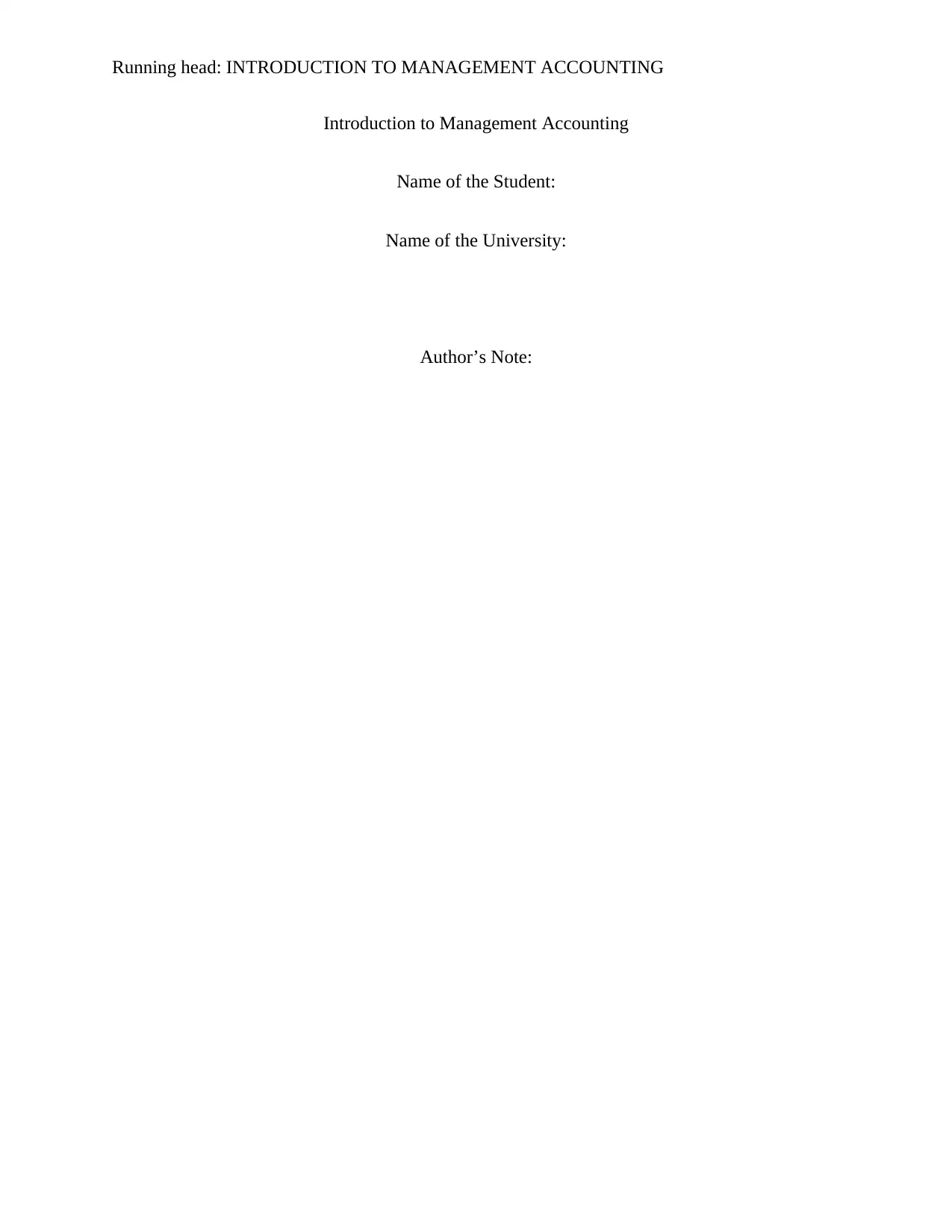
Running head: INTRODUCTION TO MANAGEMENT ACCOUNTING
Introduction to Management Accounting
Name of the Student:
Name of the University:
Author’s Note:
Introduction to Management Accounting
Name of the Student:
Name of the University:
Author’s Note:
Paraphrase This Document
Need a fresh take? Get an instant paraphrase of this document with our AI Paraphraser
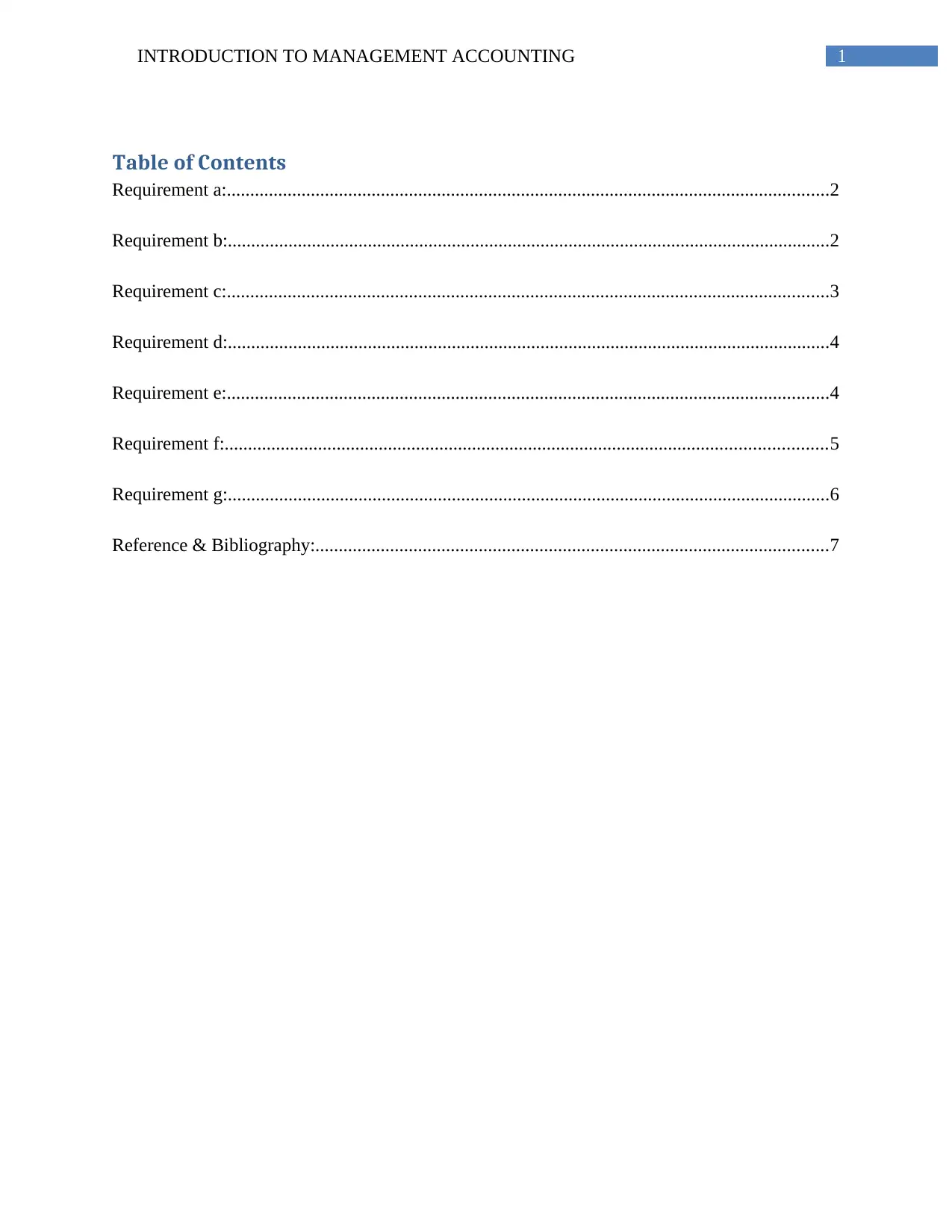
1INTRODUCTION TO MANAGEMENT ACCOUNTING
Table of Contents
Requirement a:.................................................................................................................................2
Requirement b:.................................................................................................................................2
Requirement c:.................................................................................................................................3
Requirement d:.................................................................................................................................4
Requirement e:.................................................................................................................................4
Requirement f:.................................................................................................................................5
Requirement g:.................................................................................................................................6
Reference & Bibliography:..............................................................................................................7
Table of Contents
Requirement a:.................................................................................................................................2
Requirement b:.................................................................................................................................2
Requirement c:.................................................................................................................................3
Requirement d:.................................................................................................................................4
Requirement e:.................................................................................................................................4
Requirement f:.................................................................................................................................5
Requirement g:.................................................................................................................................6
Reference & Bibliography:..............................................................................................................7
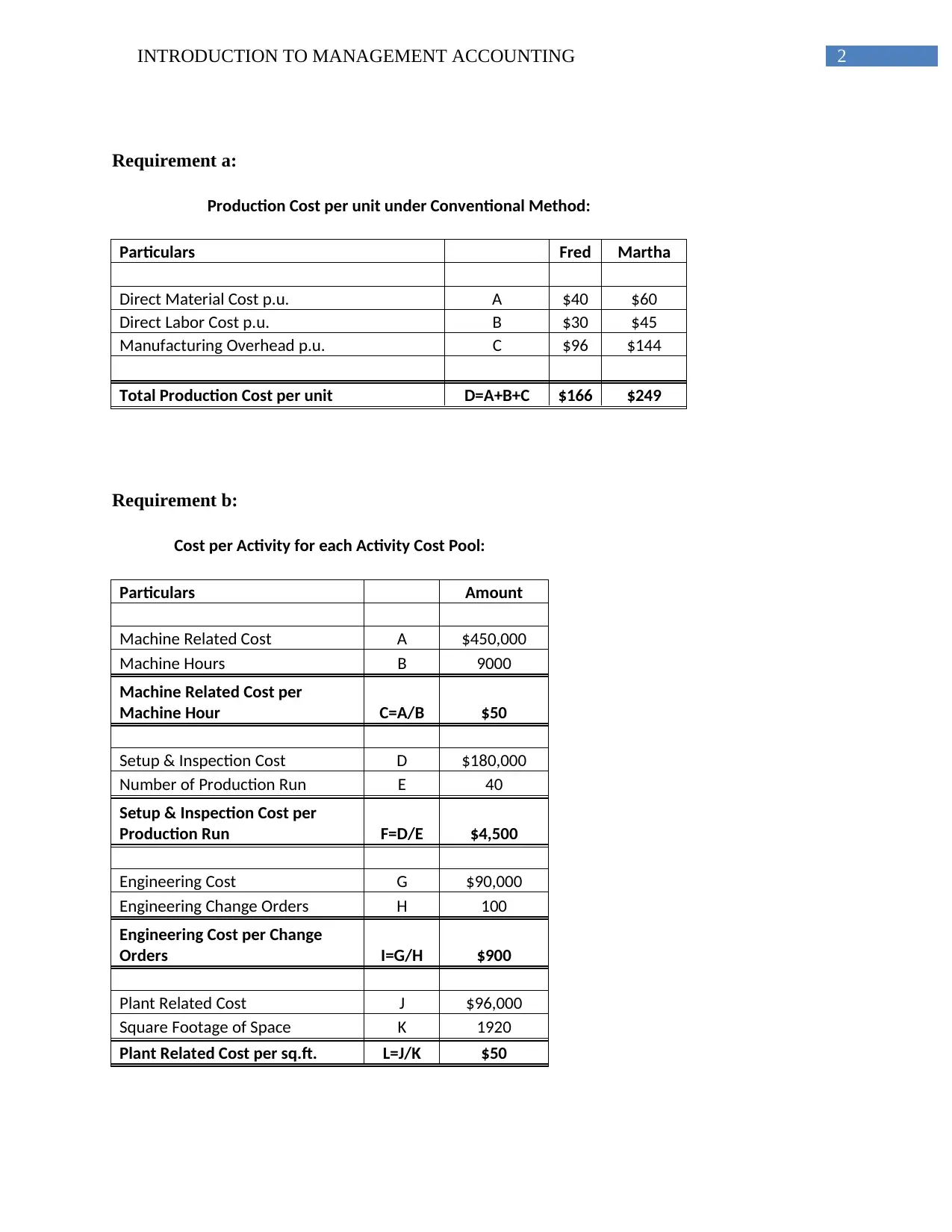
2INTRODUCTION TO MANAGEMENT ACCOUNTING
Requirement a:
Production Cost per unit under Conventional Method:
Particulars Fred Martha
Direct Material Cost p.u. A $40 $60
Direct Labor Cost p.u. B $30 $45
Manufacturing Overhead p.u. C $96 $144
Total Production Cost per unit D=A+B+C $166 $249
Requirement b:
Cost per Activity for each Activity Cost Pool:
Particulars Amount
Machine Related Cost A $450,000
Machine Hours B 9000
Machine Related Cost per
Machine Hour C=A/B $50
Setup & Inspection Cost D $180,000
Number of Production Run E 40
Setup & Inspection Cost per
Production Run F=D/E $4,500
Engineering Cost G $90,000
Engineering Change Orders H 100
Engineering Cost per Change
Orders I=G/H $900
Plant Related Cost J $96,000
Square Footage of Space K 1920
Plant Related Cost per sq.ft. L=J/K $50
Requirement a:
Production Cost per unit under Conventional Method:
Particulars Fred Martha
Direct Material Cost p.u. A $40 $60
Direct Labor Cost p.u. B $30 $45
Manufacturing Overhead p.u. C $96 $144
Total Production Cost per unit D=A+B+C $166 $249
Requirement b:
Cost per Activity for each Activity Cost Pool:
Particulars Amount
Machine Related Cost A $450,000
Machine Hours B 9000
Machine Related Cost per
Machine Hour C=A/B $50
Setup & Inspection Cost D $180,000
Number of Production Run E 40
Setup & Inspection Cost per
Production Run F=D/E $4,500
Engineering Cost G $90,000
Engineering Change Orders H 100
Engineering Cost per Change
Orders I=G/H $900
Plant Related Cost J $96,000
Square Footage of Space K 1920
Plant Related Cost per sq.ft. L=J/K $50
⊘ This is a preview!⊘
Do you want full access?
Subscribe today to unlock all pages.

Trusted by 1+ million students worldwide
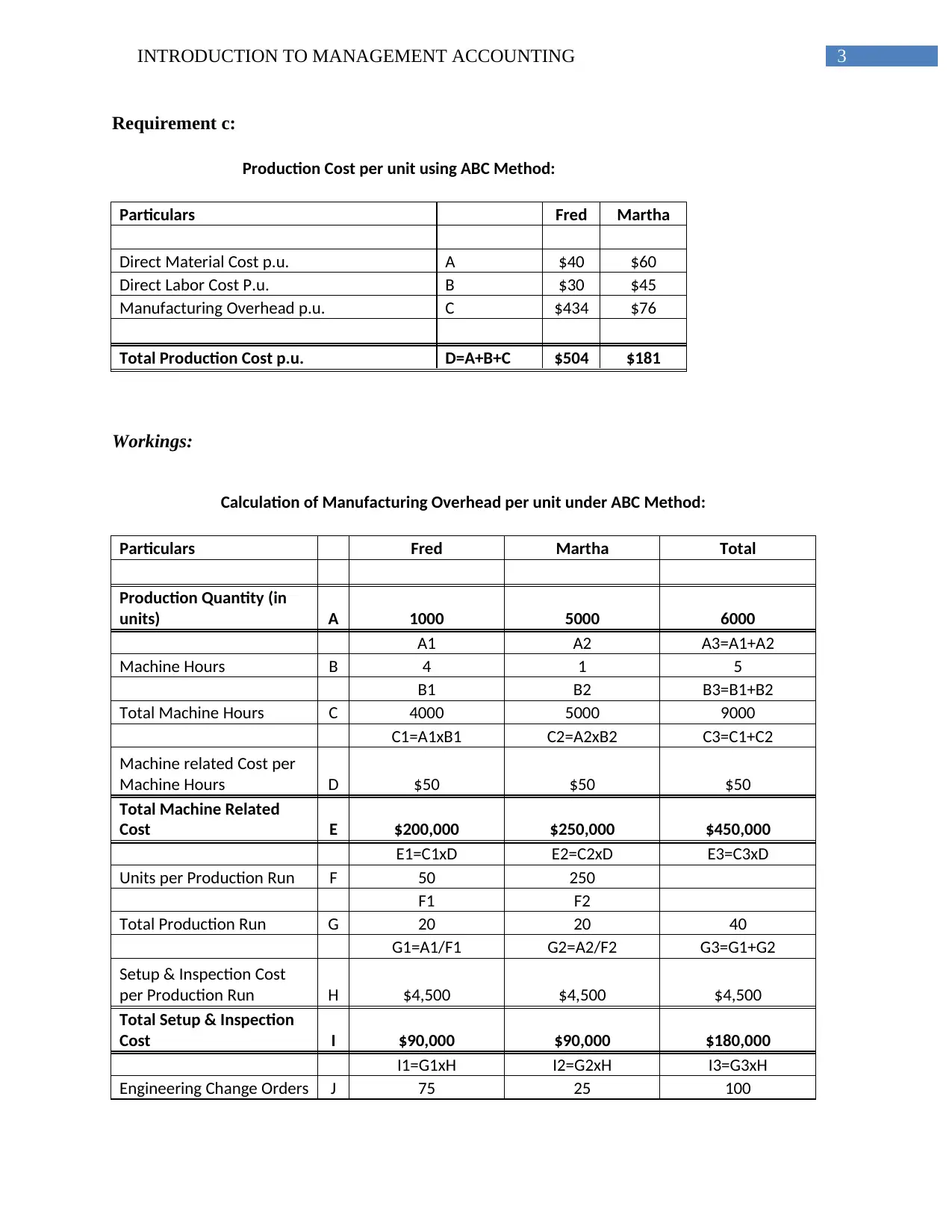
3INTRODUCTION TO MANAGEMENT ACCOUNTING
Requirement c:
Production Cost per unit using ABC Method:
Particulars Fred Martha
Direct Material Cost p.u. A $40 $60
Direct Labor Cost P.u. B $30 $45
Manufacturing Overhead p.u. C $434 $76
Total Production Cost p.u. D=A+B+C $504 $181
Workings:
Calculation of Manufacturing Overhead per unit under ABC Method:
Particulars Fred Martha Total
Production Quantity (in
units) A 1000 5000 6000
A1 A2 A3=A1+A2
Machine Hours B 4 1 5
B1 B2 B3=B1+B2
Total Machine Hours C 4000 5000 9000
C1=A1xB1 C2=A2xB2 C3=C1+C2
Machine related Cost per
Machine Hours D $50 $50 $50
Total Machine Related
Cost E $200,000 $250,000 $450,000
E1=C1xD E2=C2xD E3=C3xD
Units per Production Run F 50 250
F1 F2
Total Production Run G 20 20 40
G1=A1/F1 G2=A2/F2 G3=G1+G2
Setup & Inspection Cost
per Production Run H $4,500 $4,500 $4,500
Total Setup & Inspection
Cost I $90,000 $90,000 $180,000
I1=G1xH I2=G2xH I3=G3xH
Engineering Change Orders J 75 25 100
Requirement c:
Production Cost per unit using ABC Method:
Particulars Fred Martha
Direct Material Cost p.u. A $40 $60
Direct Labor Cost P.u. B $30 $45
Manufacturing Overhead p.u. C $434 $76
Total Production Cost p.u. D=A+B+C $504 $181
Workings:
Calculation of Manufacturing Overhead per unit under ABC Method:
Particulars Fred Martha Total
Production Quantity (in
units) A 1000 5000 6000
A1 A2 A3=A1+A2
Machine Hours B 4 1 5
B1 B2 B3=B1+B2
Total Machine Hours C 4000 5000 9000
C1=A1xB1 C2=A2xB2 C3=C1+C2
Machine related Cost per
Machine Hours D $50 $50 $50
Total Machine Related
Cost E $200,000 $250,000 $450,000
E1=C1xD E2=C2xD E3=C3xD
Units per Production Run F 50 250
F1 F2
Total Production Run G 20 20 40
G1=A1/F1 G2=A2/F2 G3=G1+G2
Setup & Inspection Cost
per Production Run H $4,500 $4,500 $4,500
Total Setup & Inspection
Cost I $90,000 $90,000 $180,000
I1=G1xH I2=G2xH I3=G3xH
Engineering Change Orders J 75 25 100
Paraphrase This Document
Need a fresh take? Get an instant paraphrase of this document with our AI Paraphraser
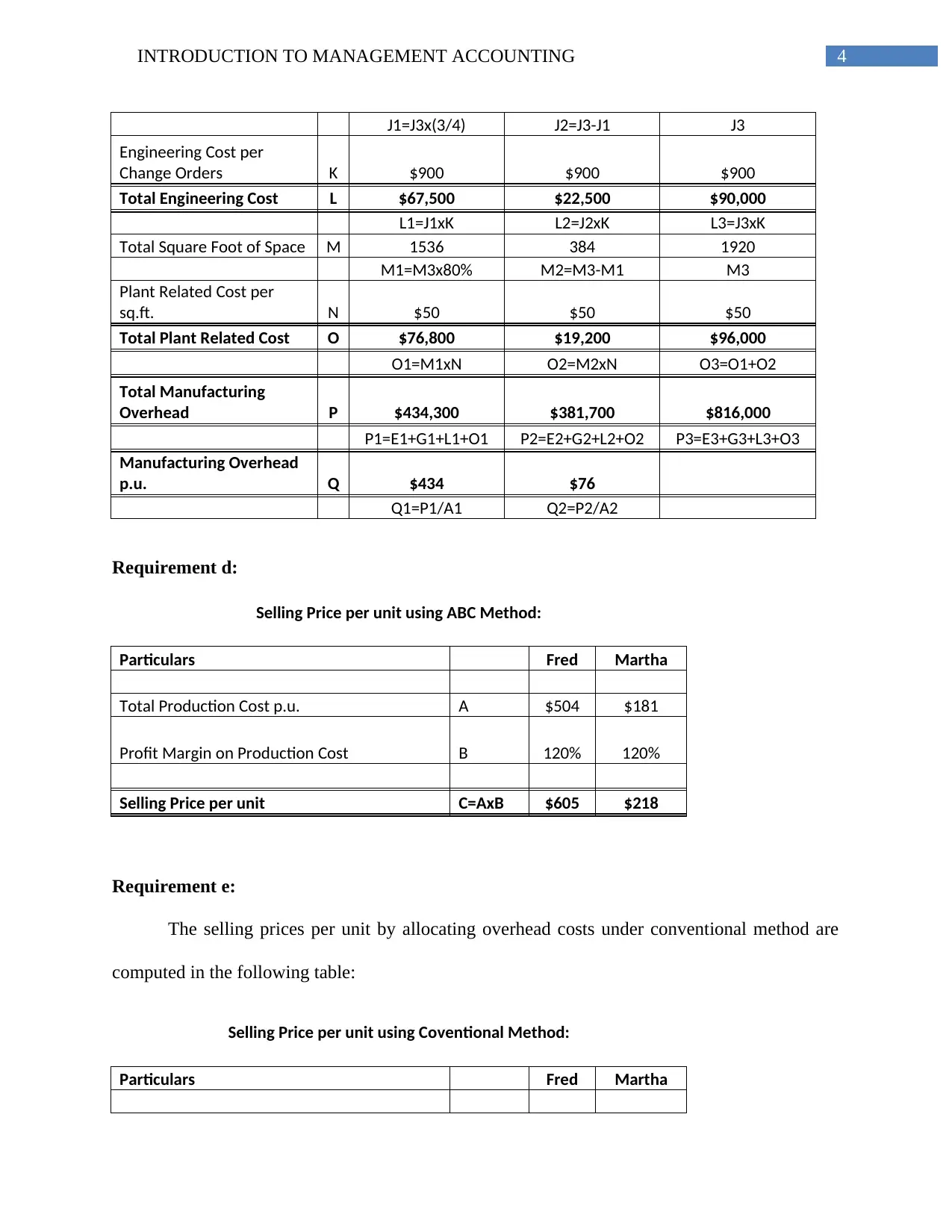
4INTRODUCTION TO MANAGEMENT ACCOUNTING
J1=J3x(3/4) J2=J3-J1 J3
Engineering Cost per
Change Orders K $900 $900 $900
Total Engineering Cost L $67,500 $22,500 $90,000
L1=J1xK L2=J2xK L3=J3xK
Total Square Foot of Space M 1536 384 1920
M1=M3x80% M2=M3-M1 M3
Plant Related Cost per
sq.ft. N $50 $50 $50
Total Plant Related Cost O $76,800 $19,200 $96,000
O1=M1xN O2=M2xN O3=O1+O2
Total Manufacturing
Overhead P $434,300 $381,700 $816,000
P1=E1+G1+L1+O1 P2=E2+G2+L2+O2 P3=E3+G3+L3+O3
Manufacturing Overhead
p.u. Q $434 $76
Q1=P1/A1 Q2=P2/A2
Requirement d:
Selling Price per unit using ABC Method:
Particulars Fred Martha
Total Production Cost p.u. A $504 $181
Profit Margin on Production Cost B 120% 120%
Selling Price per unit C=AxB $605 $218
Requirement e:
The selling prices per unit by allocating overhead costs under conventional method are
computed in the following table:
Selling Price per unit using Coventional Method:
Particulars Fred Martha
J1=J3x(3/4) J2=J3-J1 J3
Engineering Cost per
Change Orders K $900 $900 $900
Total Engineering Cost L $67,500 $22,500 $90,000
L1=J1xK L2=J2xK L3=J3xK
Total Square Foot of Space M 1536 384 1920
M1=M3x80% M2=M3-M1 M3
Plant Related Cost per
sq.ft. N $50 $50 $50
Total Plant Related Cost O $76,800 $19,200 $96,000
O1=M1xN O2=M2xN O3=O1+O2
Total Manufacturing
Overhead P $434,300 $381,700 $816,000
P1=E1+G1+L1+O1 P2=E2+G2+L2+O2 P3=E3+G3+L3+O3
Manufacturing Overhead
p.u. Q $434 $76
Q1=P1/A1 Q2=P2/A2
Requirement d:
Selling Price per unit using ABC Method:
Particulars Fred Martha
Total Production Cost p.u. A $504 $181
Profit Margin on Production Cost B 120% 120%
Selling Price per unit C=AxB $605 $218
Requirement e:
The selling prices per unit by allocating overhead costs under conventional method are
computed in the following table:
Selling Price per unit using Coventional Method:
Particulars Fred Martha
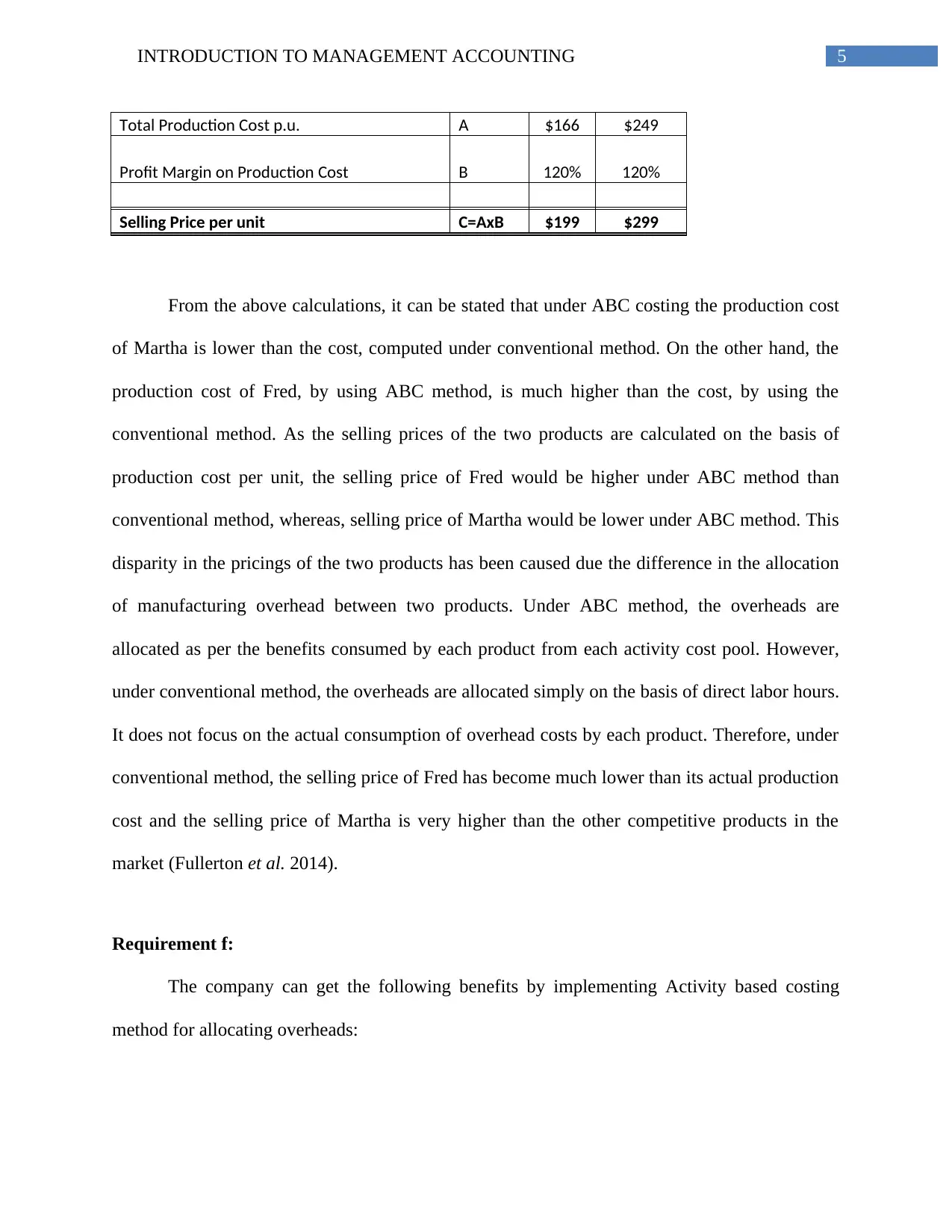
5INTRODUCTION TO MANAGEMENT ACCOUNTING
Total Production Cost p.u. A $166 $249
Profit Margin on Production Cost B 120% 120%
Selling Price per unit C=AxB $199 $299
From the above calculations, it can be stated that under ABC costing the production cost
of Martha is lower than the cost, computed under conventional method. On the other hand, the
production cost of Fred, by using ABC method, is much higher than the cost, by using the
conventional method. As the selling prices of the two products are calculated on the basis of
production cost per unit, the selling price of Fred would be higher under ABC method than
conventional method, whereas, selling price of Martha would be lower under ABC method. This
disparity in the pricings of the two products has been caused due the difference in the allocation
of manufacturing overhead between two products. Under ABC method, the overheads are
allocated as per the benefits consumed by each product from each activity cost pool. However,
under conventional method, the overheads are allocated simply on the basis of direct labor hours.
It does not focus on the actual consumption of overhead costs by each product. Therefore, under
conventional method, the selling price of Fred has become much lower than its actual production
cost and the selling price of Martha is very higher than the other competitive products in the
market (Fullerton et al. 2014).
Requirement f:
The company can get the following benefits by implementing Activity based costing
method for allocating overheads:
Total Production Cost p.u. A $166 $249
Profit Margin on Production Cost B 120% 120%
Selling Price per unit C=AxB $199 $299
From the above calculations, it can be stated that under ABC costing the production cost
of Martha is lower than the cost, computed under conventional method. On the other hand, the
production cost of Fred, by using ABC method, is much higher than the cost, by using the
conventional method. As the selling prices of the two products are calculated on the basis of
production cost per unit, the selling price of Fred would be higher under ABC method than
conventional method, whereas, selling price of Martha would be lower under ABC method. This
disparity in the pricings of the two products has been caused due the difference in the allocation
of manufacturing overhead between two products. Under ABC method, the overheads are
allocated as per the benefits consumed by each product from each activity cost pool. However,
under conventional method, the overheads are allocated simply on the basis of direct labor hours.
It does not focus on the actual consumption of overhead costs by each product. Therefore, under
conventional method, the selling price of Fred has become much lower than its actual production
cost and the selling price of Martha is very higher than the other competitive products in the
market (Fullerton et al. 2014).
Requirement f:
The company can get the following benefits by implementing Activity based costing
method for allocating overheads:
⊘ This is a preview!⊘
Do you want full access?
Subscribe today to unlock all pages.

Trusted by 1+ million students worldwide
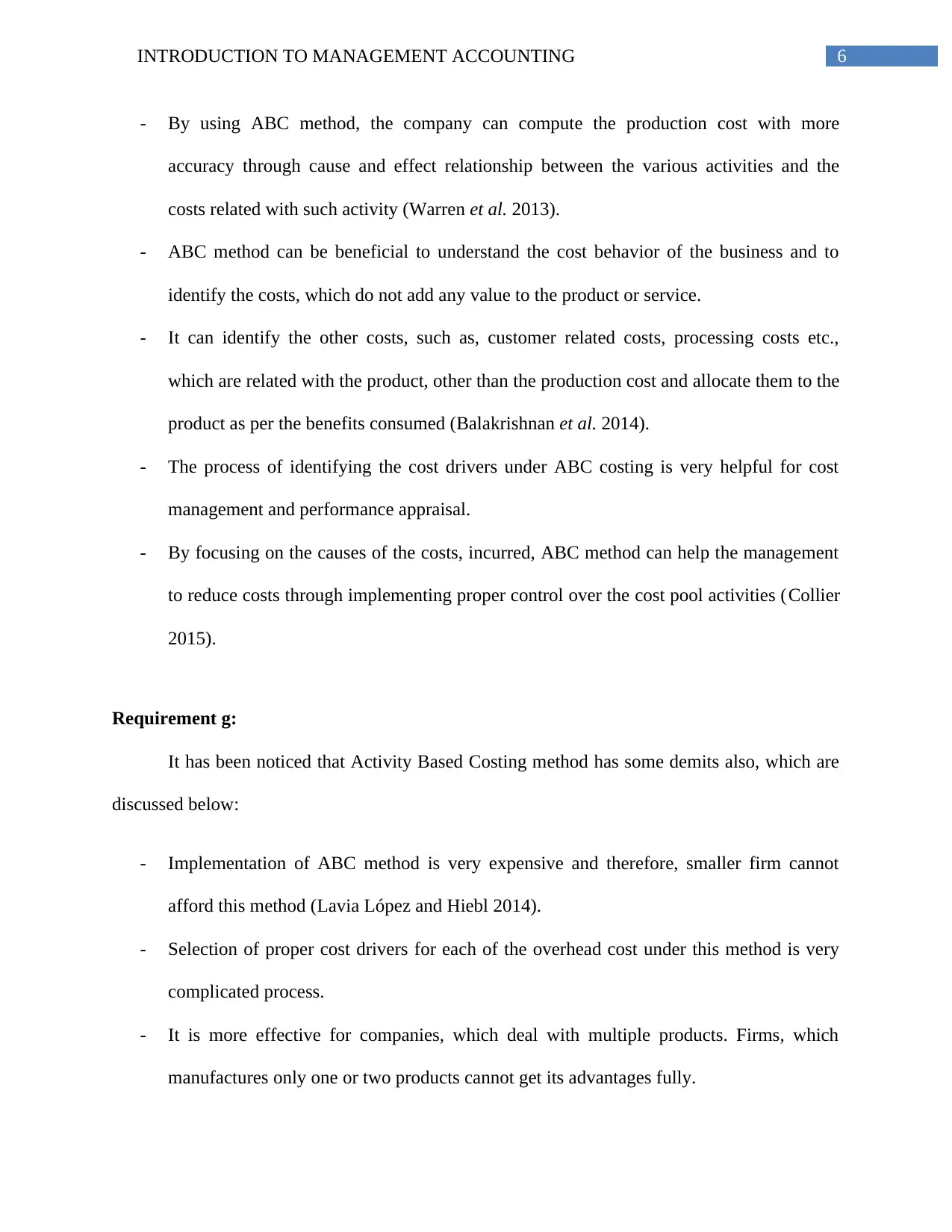
6INTRODUCTION TO MANAGEMENT ACCOUNTING
- By using ABC method, the company can compute the production cost with more
accuracy through cause and effect relationship between the various activities and the
costs related with such activity (Warren et al. 2013).
- ABC method can be beneficial to understand the cost behavior of the business and to
identify the costs, which do not add any value to the product or service.
- It can identify the other costs, such as, customer related costs, processing costs etc.,
which are related with the product, other than the production cost and allocate them to the
product as per the benefits consumed (Balakrishnan et al. 2014).
- The process of identifying the cost drivers under ABC costing is very helpful for cost
management and performance appraisal.
- By focusing on the causes of the costs, incurred, ABC method can help the management
to reduce costs through implementing proper control over the cost pool activities (Collier
2015).
Requirement g:
It has been noticed that Activity Based Costing method has some demits also, which are
discussed below:
- Implementation of ABC method is very expensive and therefore, smaller firm cannot
afford this method (Lavia López and Hiebl 2014).
- Selection of proper cost drivers for each of the overhead cost under this method is very
complicated process.
- It is more effective for companies, which deal with multiple products. Firms, which
manufactures only one or two products cannot get its advantages fully.
- By using ABC method, the company can compute the production cost with more
accuracy through cause and effect relationship between the various activities and the
costs related with such activity (Warren et al. 2013).
- ABC method can be beneficial to understand the cost behavior of the business and to
identify the costs, which do not add any value to the product or service.
- It can identify the other costs, such as, customer related costs, processing costs etc.,
which are related with the product, other than the production cost and allocate them to the
product as per the benefits consumed (Balakrishnan et al. 2014).
- The process of identifying the cost drivers under ABC costing is very helpful for cost
management and performance appraisal.
- By focusing on the causes of the costs, incurred, ABC method can help the management
to reduce costs through implementing proper control over the cost pool activities (Collier
2015).
Requirement g:
It has been noticed that Activity Based Costing method has some demits also, which are
discussed below:
- Implementation of ABC method is very expensive and therefore, smaller firm cannot
afford this method (Lavia López and Hiebl 2014).
- Selection of proper cost drivers for each of the overhead cost under this method is very
complicated process.
- It is more effective for companies, which deal with multiple products. Firms, which
manufactures only one or two products cannot get its advantages fully.
Paraphrase This Document
Need a fresh take? Get an instant paraphrase of this document with our AI Paraphraser
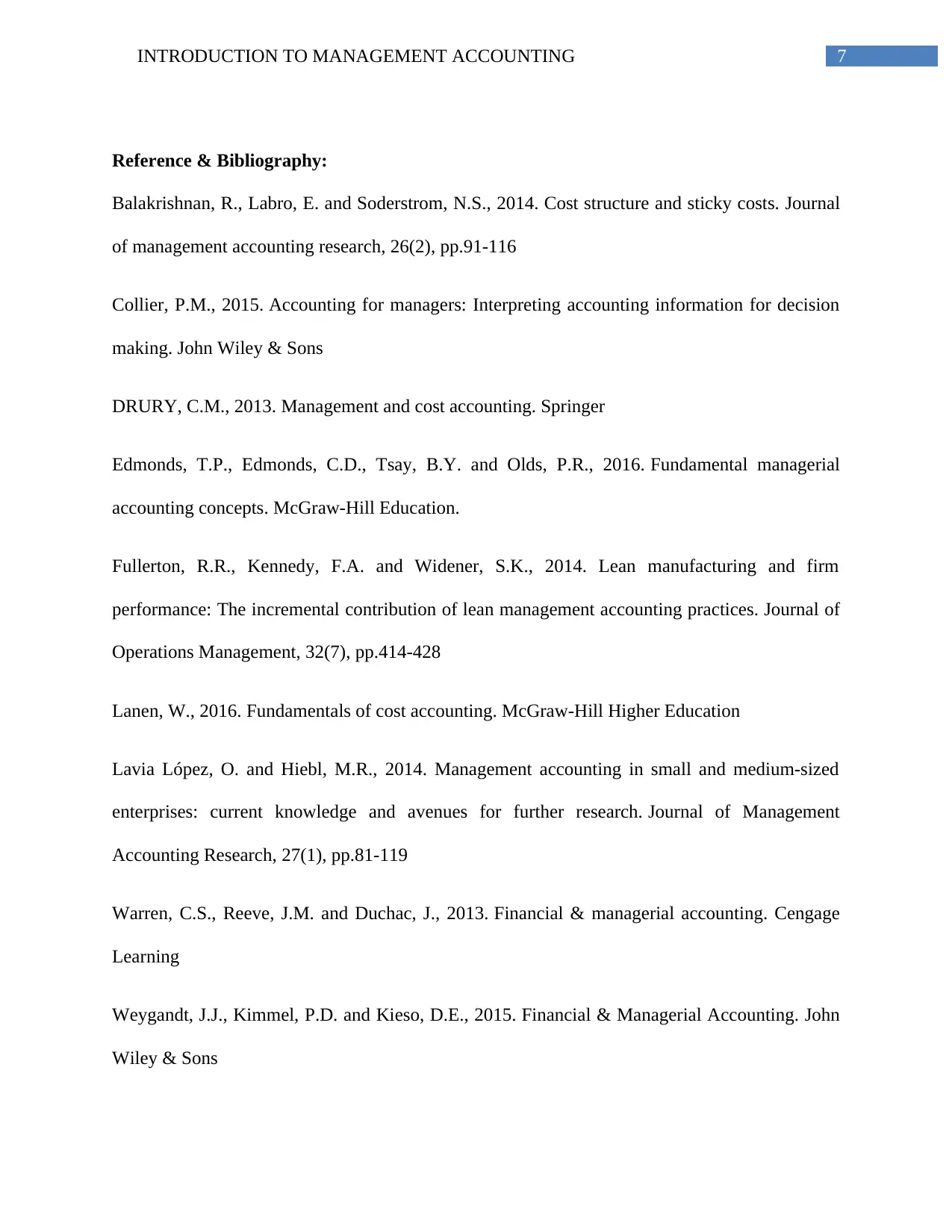
7INTRODUCTION TO MANAGEMENT ACCOUNTING
Reference & Bibliography:
Balakrishnan, R., Labro, E. and Soderstrom, N.S., 2014. Cost structure and sticky costs. Journal
of management accounting research, 26(2), pp.91-116
Collier, P.M., 2015. Accounting for managers: Interpreting accounting information for decision
making. John Wiley & Sons
DRURY, C.M., 2013. Management and cost accounting. Springer
Edmonds, T.P., Edmonds, C.D., Tsay, B.Y. and Olds, P.R., 2016. Fundamental managerial
accounting concepts. McGraw-Hill Education.
Fullerton, R.R., Kennedy, F.A. and Widener, S.K., 2014. Lean manufacturing and firm
performance: The incremental contribution of lean management accounting practices. Journal of
Operations Management, 32(7), pp.414-428
Lanen, W., 2016. Fundamentals of cost accounting. McGraw-Hill Higher Education
Lavia López, O. and Hiebl, M.R., 2014. Management accounting in small and medium-sized
enterprises: current knowledge and avenues for further research. Journal of Management
Accounting Research, 27(1), pp.81-119
Warren, C.S., Reeve, J.M. and Duchac, J., 2013. Financial & managerial accounting. Cengage
Learning
Weygandt, J.J., Kimmel, P.D. and Kieso, D.E., 2015. Financial & Managerial Accounting. John
Wiley & Sons
Reference & Bibliography:
Balakrishnan, R., Labro, E. and Soderstrom, N.S., 2014. Cost structure and sticky costs. Journal
of management accounting research, 26(2), pp.91-116
Collier, P.M., 2015. Accounting for managers: Interpreting accounting information for decision
making. John Wiley & Sons
DRURY, C.M., 2013. Management and cost accounting. Springer
Edmonds, T.P., Edmonds, C.D., Tsay, B.Y. and Olds, P.R., 2016. Fundamental managerial
accounting concepts. McGraw-Hill Education.
Fullerton, R.R., Kennedy, F.A. and Widener, S.K., 2014. Lean manufacturing and firm
performance: The incremental contribution of lean management accounting practices. Journal of
Operations Management, 32(7), pp.414-428
Lanen, W., 2016. Fundamentals of cost accounting. McGraw-Hill Higher Education
Lavia López, O. and Hiebl, M.R., 2014. Management accounting in small and medium-sized
enterprises: current knowledge and avenues for further research. Journal of Management
Accounting Research, 27(1), pp.81-119
Warren, C.S., Reeve, J.M. and Duchac, J., 2013. Financial & managerial accounting. Cengage
Learning
Weygandt, J.J., Kimmel, P.D. and Kieso, D.E., 2015. Financial & Managerial Accounting. John
Wiley & Sons
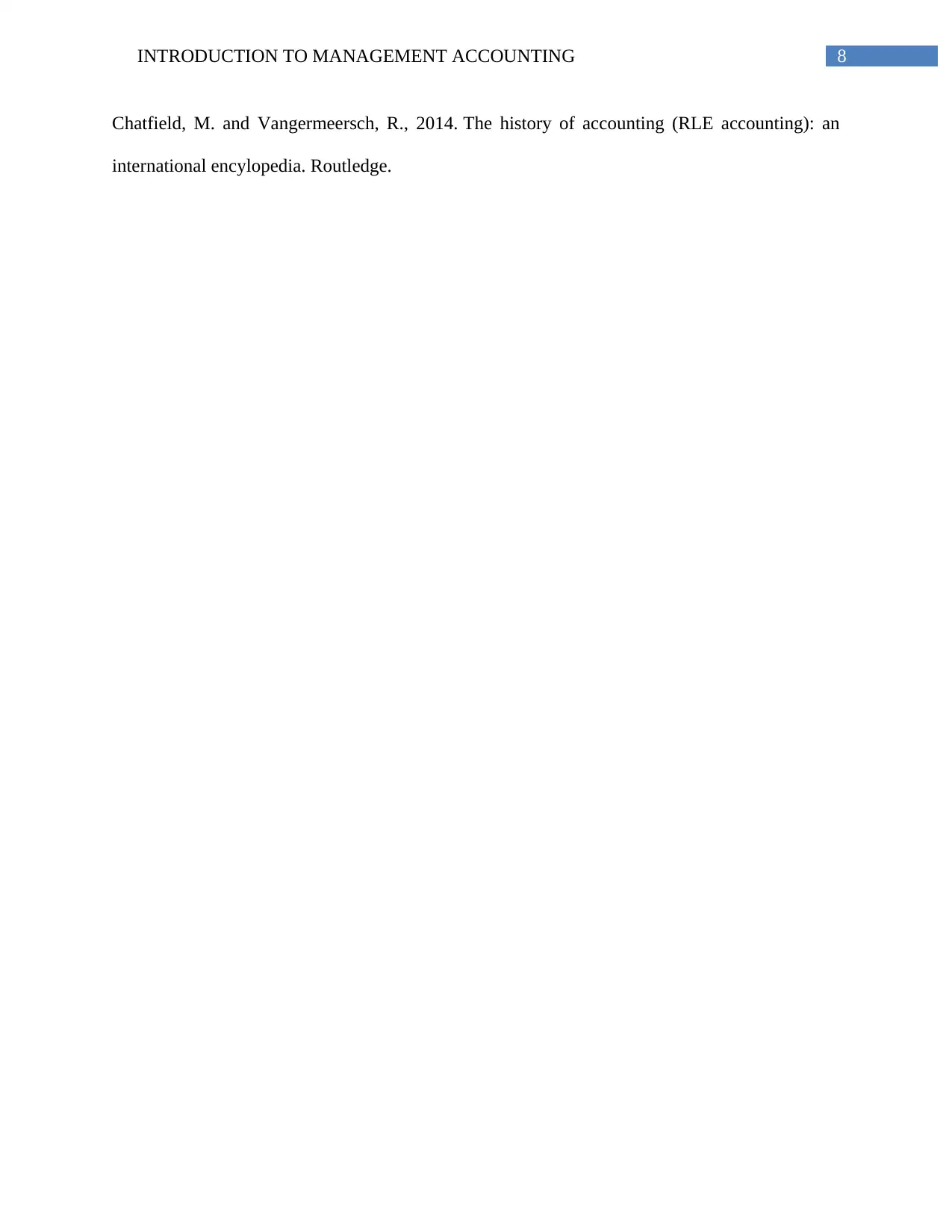
8INTRODUCTION TO MANAGEMENT ACCOUNTING
Chatfield, M. and Vangermeersch, R., 2014. The history of accounting (RLE accounting): an
international encylopedia. Routledge.
Chatfield, M. and Vangermeersch, R., 2014. The history of accounting (RLE accounting): an
international encylopedia. Routledge.
⊘ This is a preview!⊘
Do you want full access?
Subscribe today to unlock all pages.

Trusted by 1+ million students worldwide
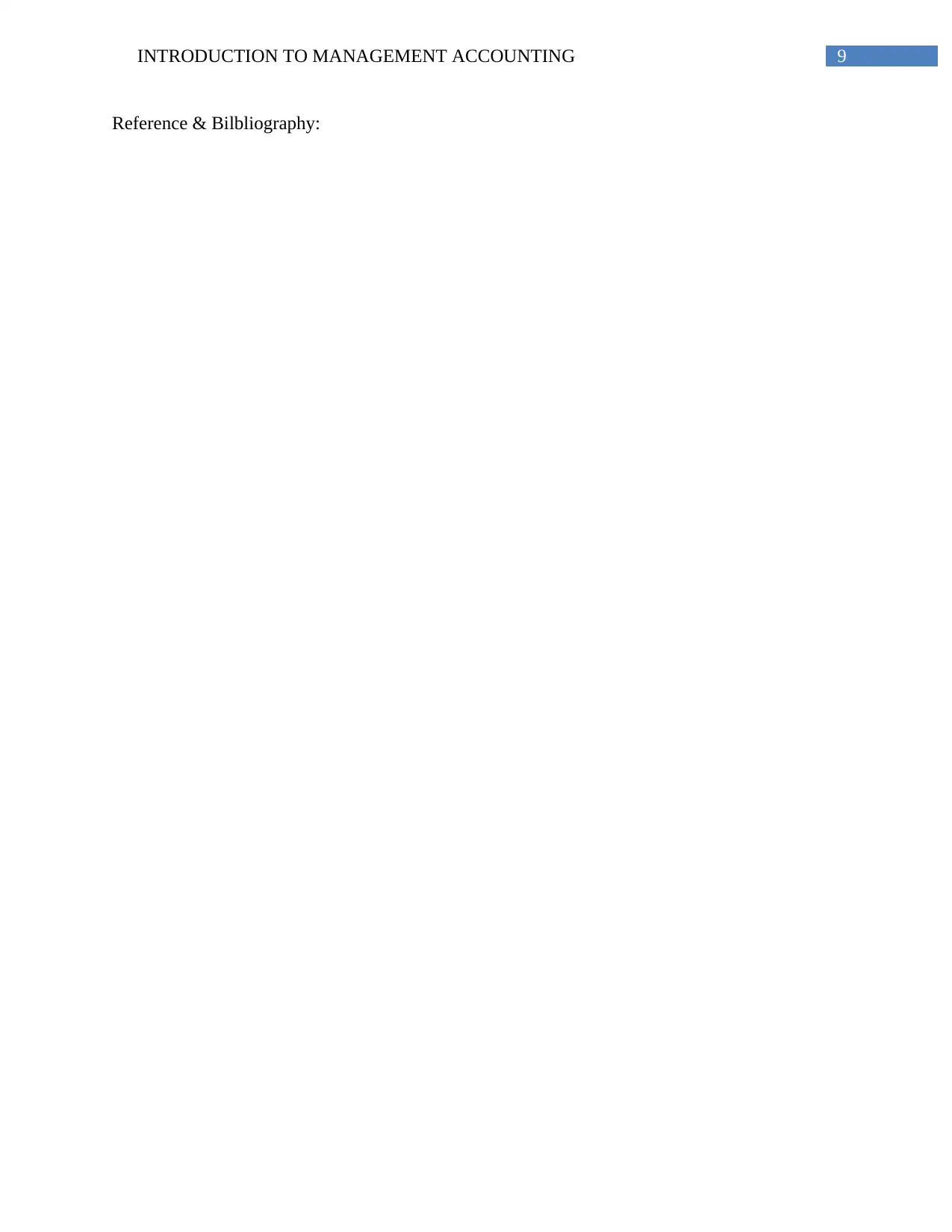
9INTRODUCTION TO MANAGEMENT ACCOUNTING
Reference & Bilbliography:
Reference & Bilbliography:
1 out of 10
Related Documents
Your All-in-One AI-Powered Toolkit for Academic Success.
+13062052269
info@desklib.com
Available 24*7 on WhatsApp / Email
![[object Object]](/_next/static/media/star-bottom.7253800d.svg)
Unlock your academic potential
Copyright © 2020–2025 A2Z Services. All Rights Reserved. Developed and managed by ZUCOL.





